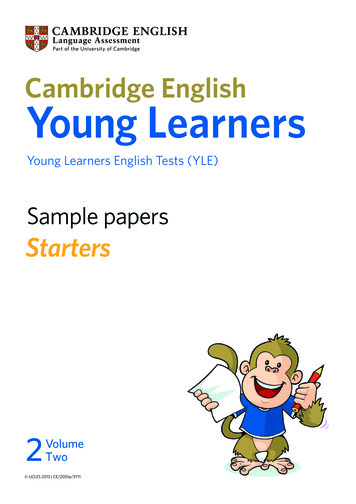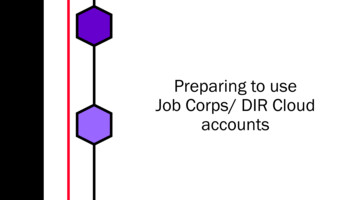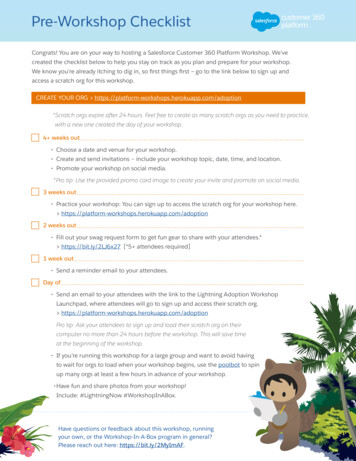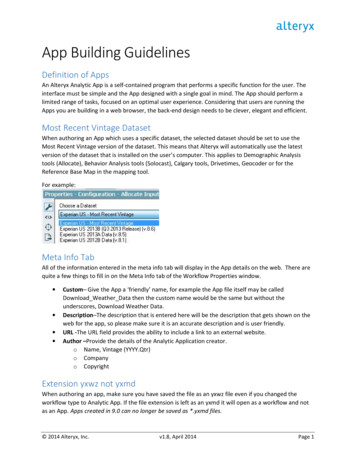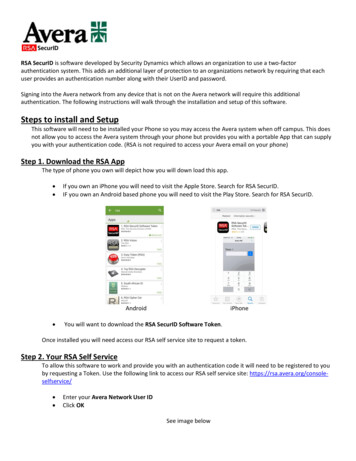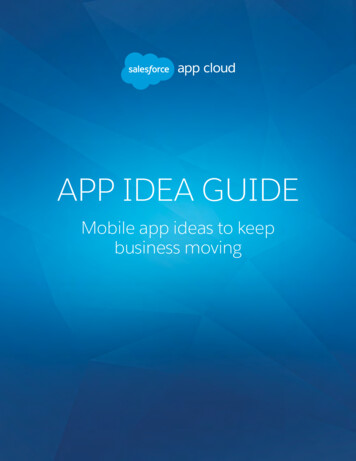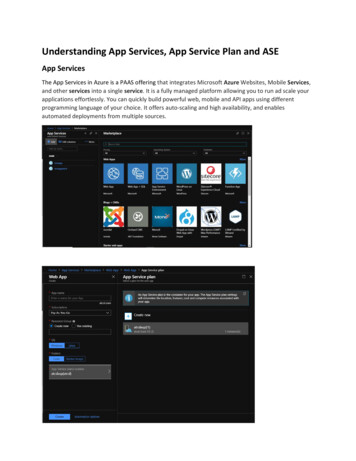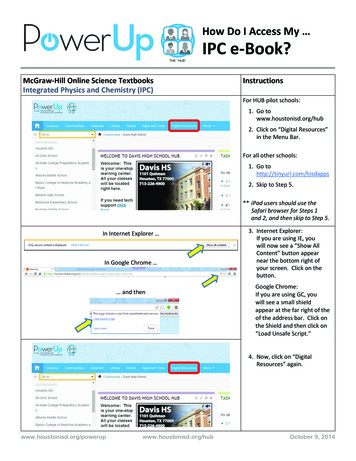
Transcription
Building a bird recognition app and large scale dataset with citizen scientists:The fine print in fine-grained dataset collectionGrant Van Horn1Steve Branson1Ryan Farrell234Jessie BarryPanos IpeirotisPietro Perona11Caltech 2 BYU 3 Cornell Lab of Ornithology 4 NYUAbstractScott Haber3Serge Belongie55Cornell Techhuman labor required. As we increase the number of classesof interest, classes become more fine-grained and difficultto distinguish for the average person (and the average annotator), more ambiguous, and less likely to obey an assumption of mutual exclusion. The annotation process becomesmore challenging, requiring an increasing amount of skilland knowledge. Dataset quality appears to be at direct oddswith dataset size.In this paper, we introduce tools and methodologies forconstructing large, high quality computer vision datasets,based on tapping into an alternate pool of crowd annotators – citizen scientists. Citizen scientists are nonprofessional scientists or enthusiasts in a particular domain such asbirds, insects, plants, airplanes, shoes, or architecture. Citizen scientists contribute annotations with the understandingthat their expertise and passion in a domain of interest canhelp build tools that will be of service to a community ofpeers. Unlike workers on Mechanical Turk, citizen scientists are unpaid. Despite this, they produce higher qualityannotations due to their greater expertise and the absence ofspammers. Additionally, citizen scientists can help defineand organically grow the set of classes and its taxonomicWe introduce tools and methodologies to collect highquality, large scale fine-grained computer vision datasetsusing citizen scientists – crowd annotators who are passionate and knowledgeable about specific domains such as birdsor airplanes. We worked with citizen scientists and domainexperts to collect NABirds, a new high quality dataset containing 48,562 images of North American birds with 555categories, part annotations and bounding boxes. We findthat citizen scientists are significantly more accurate thanMechanical Turkers at zero cost. We worked with bird experts to measure the quality of popular datasets like CUB200-2011 and ImageNet and found class label error ratesof at least 4%. Nevertheless, we found that learning algorithms are surprisingly robust to annotation errors and thislevel of training data corruption can lead to an acceptablysmall increase in test error if the training set has sufficientsize. At the same time, we found that an expert-curated highquality test set like NABirds is necessary to accurately measure the performance of fine-grained computer vision systems. We used NABirds to train a publicly available birdrecognition service deployed on the web site of the CornellLab of Ornithology.11. IntroductionComputer vision systems – catalyzed by the availability of new, larger scale datasets like ImageNet [6] – haverecently obtained remarkable performance on object recognition [17, 32] and detection [10]. Computer vision has entered an era of big data, where the ability to collect largerdatasets – larger in terms of the number of classes, the number of images per class, and the level of annotation per image – appears to be paramount for continuing performanceimprovement and expanding the set of solvable applications.Unfortunately, expanding datasets in this fashion introduces new challenges beyond just increasing the amount ofFigure 1: Merlin Photo ID: a publicly available tool for birdspecies classification built with the help of citizen scientists. Theuser uploaded a picture of a bird, and server-side computer visionalgorithms identified it as an immature Cooper’s Hawk.1 merlin.allaboutbirds.org1
structure to match the interests of real users in a domain ofinterest. Whereas datasets like ImageNet [6] and CUB-2002011 [35] have been valuable in fostering the developmentof computer vision algorithms, the particular set of categories chosen is somewhat arbitrary and of limited use toreal applications. The drawback of using citizen scientistsinstead of Mechanical Turkers is that the throughput of collecting annotations maybe lower, and computer vision researchers must take the time to figure out how to partnerwith different communities for each domain.We collected a large dataset of 48,562 images over 555categories of birds with part annotations and boundingboxes for each image, using a combination of citizen scientists, experts, and Mechanical Turkers. We used this datasetto build a publicly available application for bird speciesclassification. In this paper, we provide details and analysisof our experiences with the hope that they will be useful andinformative for other researchers in computer vision working on collecting larger fine-grained image datasets. We address questions like: What is the relative skill level of different types of annotators (MTurkers, citizen scientists, andexperts) for different types of annotations (fine-grained categories and parts)? What are the resulting implications interms of annotation quality, annotation cost, human annotator time, and the time it takes a requester to finish a dataset?Which types of annotations are suitable for different poolsof annotators? What types of annotation GUIs are best foreach respective pools of annotators? How important is annotation quality for the accuracy of learned computer visionalgorithms? How significant are the quality issues in existing datasets like CUB-200-2011 and ImageNet, and whatimpact has that had on computer vision performance?We summarize our contributions below:1. Methodologies to collect high quality, fine-grainedcomputer vision datasets using a new type of crowdannotators: citizen scientists.2. NABirds: a large, high quality dataset of 555 categories curated by experts.3. Merlin Photo ID: a publicly available tool for birdspecies classification.4. Detailed analysis of annotation quality, time, cost, andthroughput of MTurkers, citizen scientists, and expertsfor fine-grained category and part annotations.5. Analysis of the annotation quality of the populardatasets CUB-200 and ImageNet.6. Empirical analysis of the effect that annotation quality has when training state-of-the-art computer visionalgorithms for categorization.A high-level summary of our findings is: a) Citizen scientists have 2-4 times lower error rates than MTurkers atfine-grained bird annotation, while annotating images fasterand at zero cost. Over 500 citizen scientists annotated images in our dataset – if we can expand beyond the domainof birds, the pool of possible citzen scientist annotators ismassive. b) A curation-based interface for visualizing andmanipulating the full dataset can further improve the speedand accuracy of citizen scientists and experts. c) Even whenaveraging answers from 10 MTurkers together, MTurkershave a more than 30% error-rate at 37-way bird classification. d) The general high quality of Flickr search results (84% accurate when searching for a particular species)greatly mitigates the errors of MTurkers when collectingfine-grained datasets. e) MTurkers are as accurate and fastas citizen scientists at collecting part location annotations.f) MTurkers have faster throughput in collecting annotations than citizen scientists; however, using citizen scientists it is still realistic to annotate a dataset of around 100kimages in a domain like birds in around 1 week. g) At least4% of images in CUB-200-2011 and ImageNet have incorrect class labels, and numerous other issues including inconsistencies in the taxonomic structure, biases in terms ofwhich images were selected, and the presence of duplicateimages. h) Despite these problems, these datasets are stilleffective for computer vision research; when training CNNbased computer vision algorithms with corrupted labels, theresulting increase in test error is surprisingly low and significantly less than the level of corruption. i) A consequenceof findings (a), (d), and (h) is that training computer visionalgorithms on unfiltered Flickr search results (with no annotation) can often outperform algorithms trained when filtering by MTurker majority vote.2. Related WorkCrowdsourcing with Mechanical Turk: Amazon’s Mechanical Turk (AMT) has been an invaluable tool that hasallowed researchers to collect datasets of significantly largersize and scope than previously possible [31, 6, 20]. AMTmakes it easy to outsource simple annotation tasks to a largepool of workers. Although these workers will usually benon-experts, for many tasks it has been shown that repeatedlabeling of examples by multiple non-expert workers canproduce high quality labels [30, 37, 14]. Annotation of finegrained categories is a possible counter-example, where theaverage annotator may have little to no prior knowledge tomake a reasonable guess at fine-grained labels. For example, the average worker has little to no prior knowledge asto what type of bird a ”Semipalmated Plover” is, and herability to provide a useful guess is largely dependent on theefforts of the dataset collector to provide useful instructionsor illustrative examples. Since our objective is to collectdatasets of thousands of classes, generating high quality instructions for each category is difficult or infeasible.Crowdsourcing with expertise estimation: A possible solution is to try to automatically identify the subset of work-
ers who have adequate expertise for fine-grained classification [36, 38, 28, 22]. Although such models are promising, it seems likely that the subset of Mechanical Turkerswith expertise in a particular fine-grained domain is smallenough to make such methods impractical or challenging.Games with a purpose: Games with a purpose target alternate crowds of workers that are incentivized by construction of annotation tasks that also provide some entertainment value. Notable examples include the ESP Game [33],reCAPTCHA [34], and BubbleBank [7]. A partial inspiration to our work was Quizz [13], a system to tap into new,larger pools of unpaid annotators using Google AdWords tohelp find and recruit workers with the applicable expertise.2A limitation of games with a purpose is that they requiresome artistry to design tools that can engage users.Citizen science: The success of Wikipedia is another major inspiration to our work, where citizen scientists havecollaborated to generate a large, high quality web-basedencyclopedia. Studies have shown that citizen scientistsare incentivized by altruism, sense of community, and reciprocity [18, 26, 39], and such incentives can lead to higherquality work than monetary incentives [11].Datasets: Progress in object recognition has been accelerated by dataset construction. These advances are fueled both by the release and availability of each datasetbut also by subsequent competitions on them. Keydatasets/competitions in object recognition include Caltech101 [9], Caltech-256 [12], Pascal VOC [8] and ImageNet/ILSVRC [6, 29].Fine-grained object recognition is no exception to thistrend. Various domains have already had datasets introduced including Birds (the CUB-200 [35] and recentlyannounced Birdsnap [2] datasets), Flowers [25, 1], Dogsand Cats [15, 27, 21], Stoneflies [24], Butterflies [19]and Fish [4] along with man-made domains such as Airplanes [23], Cars [16], and Shoes[3].3. Crowdsourcing with Citizen Scientistscommunity, better than vision researchers, and so they canensure that the resulting datasets are directed towards solving real world problems.A connection must be established with these communities before they can be utilized. We worked with ornithologists at the Cornell Lab of Ornithology to build NABirds.The Lab of Ornithology provided a perfect conduit to tapinto the large citizen scientist community surrounding birds.Our partners at the Lab of Ornithology described that thebirding community, and perhaps many other taxon communities, can be segmented into several different groups, eachwith their own particular benefits. We built custom tools totake advantage of each of the segments.3.1. ExpertsExperts are the professionals of the community, and ourpartners at the Lab of Ornithology served this role. Figure 4is an example of an expert management tool (Vibe3 ) andwas designed to let expert users quickly and efficiently curate images and manipulate the taxonomy of a large dataset.Beyond simple image storage, tagging, and sharing, thebenefit of this tool is that it lets the experts define the datasettaxonomy as they see fit, and allows for the dynamic changing of the taxonomy as the need arises. For NABirds, aninteresting result of this flexibility is that bird species werefurther subdivided into “visual categories.” A “visual category” marks a sex or age or plumage attribute of the speciesthat results in a visually distinctive difference from othermembers within the same species, see Figure 2. This typeof knowledge of visual variances at the species level wouldhave been difficult to capture without the help of someoneknowledgeable about the domain.3.2. Citizen Scientist ExpertsAfter the experts, these individuals of the community arethe top tier, most skilled members. They have the confidence and experience to identify easily confused classes ofthe taxonomy. For the birding community these individuals3 vibe.visipedia.orgThe communities of enthusiasts for a taxon are an untapped work force and partner for vision researchers. Theindividuals comprising these communities tend to be veryknowledgeable about the taxon. Even those that are novicesmake up for their lack of knowledge with passion and dedication. These characteristics make these communities afundamentally different work force than the typical paidcrowd workers. When building a large, fine-grained datasetthey can be utilized to curate images with a level of accuracy that would be extremely costly with paid crowd workers, see Section 5. There is a mutual benefit as the taxoncommunities gain from having a direct influence on the construction of the dataset. They know their taxon, and their2 Theviability of this approach remains to be seen as our attempt to testit was foiled by a misunderstanding with the AdWords team.Figure 2: Two species of hawks from the NABirds dataset areseparated into 6 categories based on their visual attributes.
(a) Quiz Annotation GUI(b) Part Annotation GUIFigure 3: (a) This interface was used to collect category labels on images. Users could either use the autocomplete box or scroll througha gallery of possible birds. (b) This interface was used to collect part annotations on the images. Users were asked to mark the visibilityand location of 11 parts. See Section 3.2 and 3.3sourcing platforms.4. NABirdsFigure 4: Expert interface for rapid and efficient curation of images, and easy modification of the taxonomy. The taxonomy isdisplayed on the left and is similar to a file system structure. SeeSection 3.1were identified by their participation in eBird, a resourcethat allows birders to record and analyze their bird sightings.4 Figure 3a shows a tool that allows these members totake bird quizzes. The tool presents the user with a series ofimages and requests the species labels. The user can supply the label using the autocomplete box, or, if they are notsure, they can browse through a gallery of possible answers.At the end of the quiz, their answers can be compared withother expert answers.3.3. Citizen Scientist TurkersThis is a large, passionate segment of the communitymotivated to help their cause. This segment is not necessarily as skilled in difficult identification tasks, but theyare capable of assisting in other ways. Figure 3b shows apart annotation task that we deployed to this segment. Thetask was to simply click on all parts of the bird. The sizeof this population should not be underestimated. Depending on how these communities are reached, this populationcould be larger than the audience reached in typical crowd4 ebird.orgWe used a combination of experts, citizen scientists, andMTurkers to build NABirds, a new bird dataset of 555categories with a total of 48,562 images. Members fromthe birding community provided the images, the experts ofthe community curated the images, and a combination ofCTurkers and MTurkers annotated 11 bird parts on everyimage along with bounding boxes. This dataset is free touse for the research community.The taxonomy for this dataset contains 1011 nodes, andthe categories cover the most common North Americanbirds. These leaf categories were specifically chosen toallow for the creation of bird identification tools to helpnovice birders. Improvements on classification or detectionaccuracy by vision researchers will have a straightforwardand meaningful impact on the birding community and theiridentification tools.We used techniques from [5] to baseline performance onthis dataset. Using Caffe and the fc6 layer features extractedfrom the entire image, we achieved an accuracy of 35.7%.Using the best performing technique from [5] with groundtruth part locations, we achieved an accuracy of 75%.5. Annotator ComparisonIn this section we compare annotations performed byAmazon Mechanical Turk workers (MTurkers) with citizenscientists reached through the Lab of Ornithology’s Facebook page. The goal of these experiments was to quantifythe followings aspects of annotation tasks. 1) AnnotationError: The fraction of incorrect annotations., 2) Annotation Time: The average amount of human time required perannotation. 3) Annotation Cost: The average cost in dollars required per annotation. 4) Annotation Throughput:The average number of annotations obtainable per second,this scales with the total size of the pool of annotators.In order to compare the skill levels of different annotatorgroups directly, we chose a common user interface that we
considered to be appropriate for both citizen scientists andMTurkers. For category labeling tasks, we used the quiztool that was discussed in section 3.2. Each question presented the user with an image of a bird and requested thespecies label. To make the task feasible for MTurkers, weallowed users to browse through galleries of each possiblespecies and limited the space of possible answers to 40categories. Each quiz was focused on a particular group ofbirds, either sparrows or shorebirds. Random chance was 1/ 37 for the sparrows and 1 / 32 for the shorebirds. At theend of the quiz, users were given a score (the number of correct answers) and could view their results. Figure 3a showsour interface. We targeted the citizen scientist experts byposting the quizzes on the the eBird Facebook page.Figure 5 shows the distribution of scores achieved bythe two different worker groups on the two different birdgroups. Not surprisingly, citizen scientists had better performance on the classification task than MTurkers; howeverwe were uncertain as to whether or not averaging a largenumber of MTukers could yield comparable performance.Figure 6a plots the time taken to achieve a certain error rateby combining multiple annotators for the same image using majority voting. From this figure we can see that citizen scientists not only have a lower median time per image(about 8 seconds vs 19 seconds), but that one citizen scientist expert label is more accurate than the average of 10MTurker labels. We note that we are using a simple-aspossible (but commonly used) crowdsourcing method, andthe performance of MTurkers could likely be improved bymore sophisticated techniques such as CUBAM [36]. However, the magnitude of difference in the two groups andoverall large error rate of MTurkers led us to believe thatthe problem could not be solved simply using better crowdsourcing models.Figure 6c measures the raw throughput of the workers,highlighting the size of the MTurk worker pool. With citizen scientists, we noticed a spike of participation when theannotation task was first posted on Facebook, and then aquick tapering off of participation. Finally, Figure 6b measures the cost associated with the different levels of error–citizen scientists were unpaid.We performed a similar analysis with part annotations.For this task we used the tool shown in Figure 3b. Workers from the two different groups were given an image andasked to specify the visibility and position of 11 differentbird parts. We targeted the citizen scientist turkers with thistask by posting the tool on the Lab of Ornithology’s Facebook page. The interface for the tool was kept the same between the workers. Figures 7a, 7b, and 7c detail the resultsof this test. From Figure 7a we can see there is not a difference between the obtainable quality from the two workergroups, and that MTurkers tended to be faster at the task.Figure 7c again reveals that the raw throughput of Mturk-(a) Sparrow Quiz Scores(b) Shorebird Quiz ScoresFigure 5: Histogram of quiz scores. Each quiz has 10 images, aperfect score is 10. (a) Score distributions for the sparrow quizzes.Random chance per image is 2.7%. (b) Score distributions forthe shorebird quizzes. Random chance per image is 3.1%. SeeSection 5ers is larger than that of the citizen scientists. The primarybenefit of using citizen scientists for this particular case ismade clear by their zero cost in Figure 7b.Summary: From these results, we can see that thereare clear distinctions between the two different workerpools. Citizen scientists are clearly more capable at labelingfine-grained categories than MTurkers. However, the rawthroughput of MTurk means that you can finish annotatingyour dataset sooner than when using citizen scientists. Ifthe annotation task does not require much domain knowledge (such as part annotation), then MTurkers can performon par with citizen scientists. Gathering fine-grained category labels with MTurk should be done with care, as wehave shown that naive averaging of labels does not convergeto the correct label. Finally, the cost savings of using citizenscientists can be significant when the number of annotationtasks grows.6. Measuring the Quality of Existing DatasetsCUB-200-2011 [35] and ImageNet [6] are two populardatasets with fine-grained categories. Both of these datasetswere collected by downloading images from web searchesand curating them with Amazon Mechanical Turk. Giventhe results in the previous section, we were interested in analyzing the errors present in these datasets. With the helpof experts from the Cornell Lab of Ornithology, we examined these datasets, specifically the bird categories, for falsepositives.CUB-200-2011: The CUB-200-2011 dataset has 200classes, each with roughly 60 images. Experts went throughthe entire dataset and identified a total of 494 errors, about4.4% of the entire dataset. There was a total of 252 imagesthat did not belong in the dataset because their category wasnot represented, and a total of 242 images that needed to bemoved to existing categories. Beyond this 4.4% percent error, an additional potential concern comes from dataset bias
MTurkersCitizen ScientistsCitizen Scientists VibeAnnotations or1.0MTurkers0.9Citizen Scientists0.8Citizen Scientists Vibe0.70.6 1x0.55x0.410x0.3 1x0.25x0.1 1x3x0.0 412 20 28 36 44 52Annotation Time (hours) 0(a) Annotation Time 40 80 120 160 200Annotation rkersCitizen Scientists24(b) Annotation Cost487296Time (hours)120144(c) ThroughputFigure 6: Category Labeling Tasks: workers used the quiz interface (see Figure 3a) to label the species of birds in images. (a) CitizenMTurkersCitizen Scientists1x1x5x5x4122028Annotation Time (hours)(a) Annotation ersCitizen ScientistsAnnotations Completed1.91.81.71.61.51.41.31.21.11.00.90.8Error (Ave # Incorrect Parts)Error (Ave # Incorrect Parts)scientists are more accurate and faster for each image than MTurkers. If the citizen scientists use an expert interface (Vibe), then theyare even faster and more accurate. (b) Citizen scientists are not compensated monetarily, they donate their time to the task. (c) The totalthroughput of MTurk is still greater, meaning you can finish annotating your dataset sooner, however this comes at a monetary cost. SeeSection 51x 1x5x5x 20 60 100 140 180 220 260Annotation Cost ( en Scientists1.0(b) Annotation CostTime (hours)2.03.0(c) ThroughputFigure 7: Parts annotation tasks: workers used the interface in Figure 3b to label the visibility and location of 11 parts. (a): For this task,as opposed to the category labeling task, citizen scientists and MTurkers perform comparable on individual images. (b): Citizen scientistsdonate their time, and are not compensated monetarily. (c): The raw throughput of MTurk is greater than that of the citizen scientists,meaning you can finish your total annotation tasks sooner, but this comes at a cost. See Section 5issues. CUB was collected by performing a Flickr imagesearch for each species and using MTurkers to filter results.A consequence is that the most difficult images tended tobe excluded from the dataset altogether. By having expertsannotate the raw Flickr search results, we found that on average 11.6% of correct images of each species were incorrectly filtered out of the dataset. See Section 7.2 for additional analysis.ImageNet: There are 59 bird categories in ImageNet, eachwith about 1300 images in the training set. Table 1 showsthe false positive counts for a subset of these categories.In addition to these numbers, it was our general impression that error rate of ImageNet is probably at least as highas CUB-200 within fine-grained categories; for example,the synset “ruffed grouse, partridge, Bonasa umbellus” hadoverlapping definition and image content with the synset“partridge” beyond what was quantified in our analysis.Categorymagpiekitedowitcheralbatross, mollymarkquailptarmiganruffed grouse, partridge,Bonasa umbellusprairie chicken, prairiegrouse, prairie fowlpartridgeTraining Images1300129412981300130013001300False Positives11260709219569130052130055Table 1: False positives from ImageNet LSVRC dataset.
5% corruption15% corruption50% corruptionPure100101102log(Number of Categories)1030.900.700.500.300.105% corruption15% corruption50% corruptionPure100101102log(Number of Categories)103log(Classification Error)0.10log(Classification Error)log(Classification Error)0.900.700.500.300.500.400.300.200.100.05 corruption0.15 corruption0.50 corruptionPure100101102log(Dataset Size)103(a) Image level features, train test corruption (b) Image level features, train corruption only (c) Localized features, train corruption onlyFigure 8: Analysis of error degradation with corrupted training labels: (a) Both the training and testing sets are corrupted. There is asignificant difference when compared to the clean data. (b) Only the training set is corrupted. The induced classification error is much lessthan the corruption level. (c) Only the training set is corrupted but more part localized features are utilized. The induced classification erroris still much less than the corruption level. See Section 7.17. Effect of Annotation Quality & QuantityIn this section we analyze the effect of data quality andquantity on learned vision systems. Does the 4% error inCUB and ImageNet actually matter? We begin with simulated label corruption experiments to quantify reduction inclassification accuracy for different levels of error in Section 7.1, then perform studies on real corrupted data usingan expert-vetted version of CUB in Section 7.2.7.1. Label Corruption ExperimentsIn this experiment, we attempted to measure the effectof dataset quality by corrupting the image labels of theNABirds dataset. We speculated that if an image of trueclass X is incorrectly labeled as class Y , the effect mightbe larger if class Y is included as a category in the dataset(i.e., CUB and ImageNet include only a small subset ofreal bird species). We thus simulated class subsets by randomly picking N 555 categories to comprise our sampledataset. Then, we randomly sampled M images from the Nselected categories and corrupted these images by swappingtheir labels with another image randomly selected from all555 categories of the original NABirds dataset. We usedthis corrupted dataset of N categories to build a classifier.Note that as the number of categories N within the datasetincreases, the probability that a corrupted label is actuallyin the dataset increases. Figure 8 plots the results of thisexperiment for different configurations. We summarize ourconclusions below:5-10% Training error was tolerable: Figures 8b and 8canalyze the situation where only the training set is corrupted, and the ground truth testing set remains pure. Wesee that the increase in classification error due to 5% andeven 15% corruption are remarkably low–much smallerthan 5% and 15%. This result held regardless of the numberof classes or computer vision algorithm. This suggests thatthe level of annotation error in CUB and ImageNet ( 5%)might not be a big deal.Obtaining a clean test set was important: On the otherhand, one cannot accurately measure the performance ofcomputer vision algorithms without a high quality test set,as demonstrated in Figure 8a, which measures performancewhen the test set is also corrupted. There is clearly a significant drop in performance with even 5% corruption. Thishighlights a potential problem with CUB and ImageNet,where train and test sets are equally corrupted.Effect of computer vision algorithm: Figure 8b uses computer vision algorithms based on raw image-level CNN-fc6features (obtaining an accuracy of 35% on 555 categories)while Figure 8c uses a more sophisticated method [5] basedon pose normalization and features from multiple CNN layers (obtaining an accuracy of 74% on 555 categories). Labelcorruption caused similar additive increases in test error forboth methods; however, this was a
zen scientists contribute annotations with the understanding . A high-level summary of our findings is: a) Citizen sci- . have a more than 30% error-rate at 37-way bird classifi-cation. d) The general high quality of F
